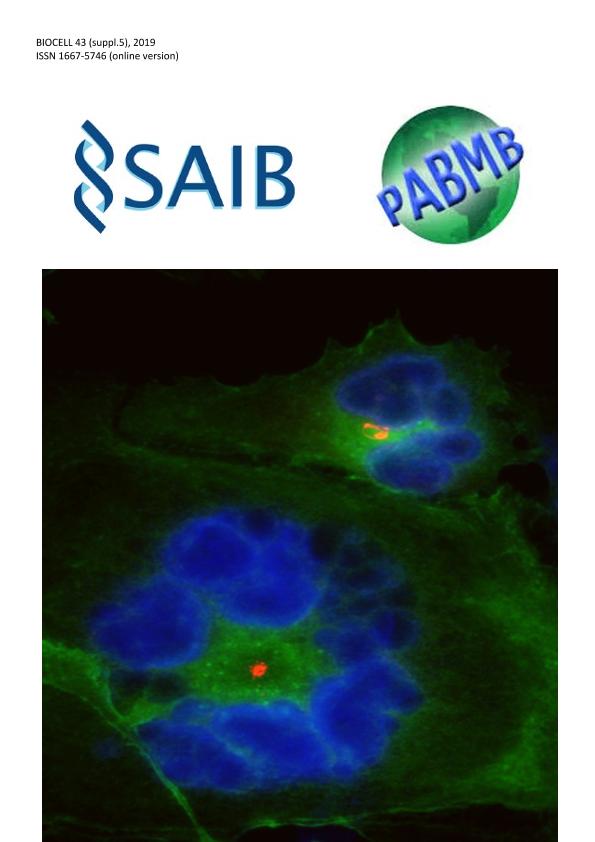Mostrar el registro sencillo del ítem
dc.contributor.author
Raimondo, Enzo Emanuel

dc.contributor.author
Costa Gutierrez, Stefanie Bernardette

dc.contributor.author
Sineli, Pedro Eugenio

dc.contributor.author
Fuentes, María Soledad

dc.contributor.author
Benimeli, Claudia Susana

dc.date.available
2022-12-21T12:01:06Z
dc.date.issued
2019
dc.identifier.citation
Evaluation of enzymatic activities in lindane-contaminated soils during their restoration by biorremediation techniques; The LV Annual SAIB Meeting and XIV PABMB Congress; Salta; Argentina; 2019; 1-6
dc.identifier.issn
1667-5746
dc.identifier.uri
http://hdl.handle.net/11336/181908
dc.description.abstract
Lindane is an organochlorine pesticide that, due to its persistence in the environment, is still detected in different matrices. Bioremediation using actinobacteria consortia and agriculture residues proved to be successful for the restoration of lindano contaminated soils. Furthermore, soil enzymatic activities including oxidoreductases and hydrolases are used as sensitive indicators to evaluate the soil quality, due to their participation in a range of biochemical reactions which take place in the environment. The aim of this work was to select soil enzymatic activities in order to be used as indicators of efficiency during the bioremediation of lindane contaminated soils. Bioremediation tests were carried out in microcosms formulated with different soil types, contaminated with 2 mg kg-1 of lindane, bioaugmented with 2 g kg-1 of an actinobacteria consortium and biostimulated with sugarcane bagasse or filter cake in the following soil:amendment proportions (100:0, 98:2, 90:10), under previously optimized conditions. The microcosms were incubated at 30 °C for 14 days and periodic samples were taken to determine lindane removal by gas chromatography and enzymatic activities using the traditional techniques reported in literature with slight variations. All appropriated controls were performed. At the end of the assay, the pesticide removal percentages were different among the treatments and soil types, and the enzymatic activities were greater at day 14 than at day 0. In bioaugmented soils, the enzymatic activities were greater than in non-bioaugmented controls. In addition, biostimulation of bioaugmented and non-bioaugmented microcosms increased the values of these biological parameters. However, it was observed that lindane had an inhibitory effect on dehydrogenase, fluorescein diacetate hydrolysis, acid and alkaline phosphatases activities, while catalase was stimulated by the pesticide. Urease was slightly inhibited or not affected by the presence of the pesticide, depending on the evaluated condition. Based on their sensitivity, catalase, fluorescein diacetate hydrolysis and acid phosphatase were selected as appropriate indicators to assess the effectiveness of the bioremediation process in subsequent studies. The obtained results demonstrated that the simultaneous use of the actinobacteria consortium and the agroindustrial residues was suitable for the treatment of soils of different textural classes contaminated with lindane, which led to an increase in the enzymatic activities values, with a consequent improve in the quality of bioremediated soils.
dc.format
application/pdf
dc.language.iso
eng
dc.publisher
Tech Science Press

dc.rights
info:eu-repo/semantics/openAccess
dc.rights.uri
https://creativecommons.org/licenses/by-nc-sa/2.5/ar/
dc.subject
LINDANE
dc.subject
BIOREMEDIATION
dc.subject
ACTINOBACTERIA
dc.subject
SOIL ENZYMES
dc.subject.classification
Bioremediación, Diagnóstico Biotecnológico en Gestión Medioambiental

dc.subject.classification
Biotecnología del Medio Ambiente

dc.subject.classification
INGENIERÍAS Y TECNOLOGÍAS

dc.title
Evaluation of enzymatic activities in lindane-contaminated soils during their restoration by biorremediation techniques
dc.type
info:eu-repo/semantics/publishedVersion
dc.type
info:eu-repo/semantics/conferenceObject
dc.type
info:ar-repo/semantics/documento de conferencia
dc.date.updated
2022-12-19T15:44:21Z
dc.journal.volume
43
dc.journal.number
Suplemento 5
dc.journal.pagination
1-6
dc.journal.pais
Argentina

dc.journal.ciudad
Mendoza
dc.description.fil
Fil: Raimondo, Enzo Emanuel. Consejo Nacional de Investigaciones Científicas y Técnicas. Centro Científico Tecnológico Conicet - Tucumán. Planta Piloto de Procesos Industriales Microbiológicos; Argentina
dc.description.fil
Fil: Costa Gutierrez, Stefanie Bernardette. Consejo Nacional de Investigaciones Científicas y Técnicas. Centro Científico Tecnológico Conicet - Tucumán. Planta Piloto de Procesos Industriales Microbiológicos; Argentina
dc.description.fil
Fil: Sineli, Pedro Eugenio. Consejo Nacional de Investigaciones Científicas y Técnicas. Centro Científico Tecnológico Conicet - Tucumán. Planta Piloto de Procesos Industriales Microbiológicos; Argentina
dc.description.fil
Fil: Fuentes, María Soledad. Consejo Nacional de Investigaciones Científicas y Técnicas. Centro Científico Tecnológico Conicet - Tucumán. Planta Piloto de Procesos Industriales Microbiológicos; Argentina
dc.description.fil
Fil: Benimeli, Claudia Susana. Consejo Nacional de Investigaciones Científicas y Técnicas. Centro Científico Tecnológico Conicet - Tucumán. Planta Piloto de Procesos Industriales Microbiológicos; Argentina
dc.relation.alternativeid
info:eu-repo/semantics/altIdentifier/url/https://techscience.com/biocell/v43nSuppl.5
dc.conicet.rol
Autor

dc.conicet.rol
Autor

dc.conicet.rol
Autor

dc.conicet.rol
Autor

dc.conicet.rol
Autor

dc.coverage
Internacional
dc.type.subtype
Reunión
dc.description.nombreEvento
The LV Annual SAIB Meeting and XIV PABMB Congress
dc.date.evento
2019-11-05
dc.description.ciudadEvento
Salta
dc.description.paisEvento
Argentina

dc.type.publicacion
Journal
dc.description.institucionOrganizadora
Sociedad Argentina de Investigación Bioquímica y Biología Molecular
dc.source.revista
Biocell

dc.date.eventoHasta
2019-11-08
dc.type
Reunión
Archivos asociados
